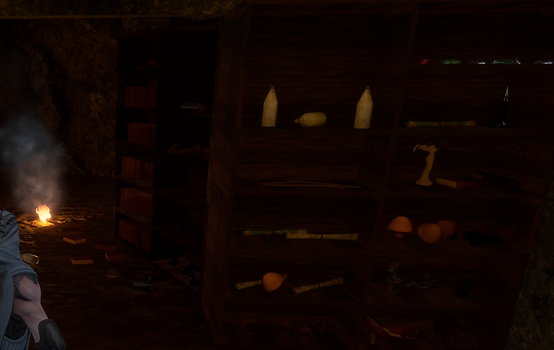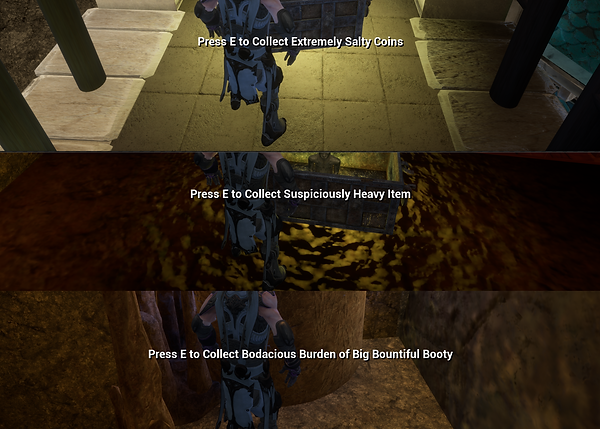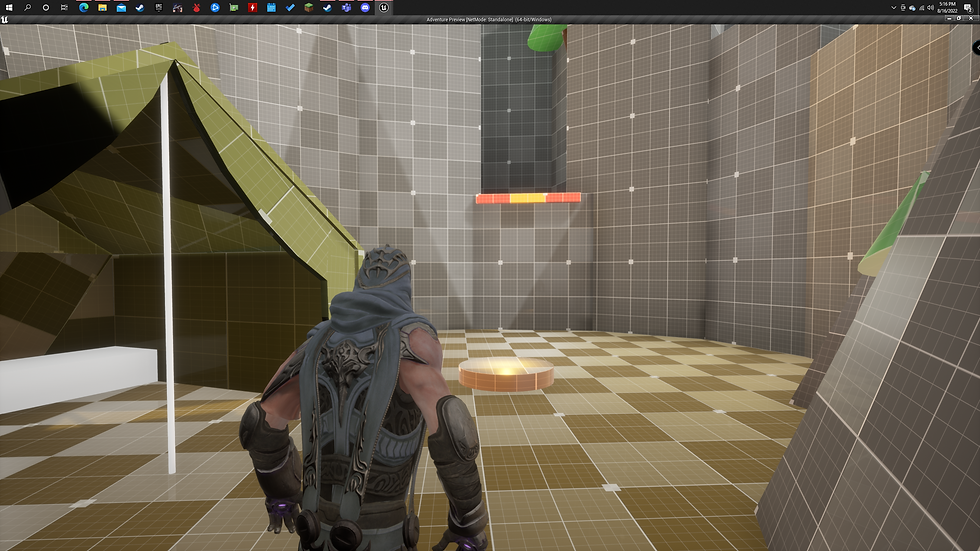
Creative Vision
-
Genre: Adventure
-
This is an “adventure game”. An adventure game has the player assume the role of a protagonist driven by exploration.
-
-
Time Period: Modern-ish
-
Our adventure must be believable, and feasible in the time period that exists between the 1700s and today.
-
-
Location: Earth-like
-
The location of this adventure must be Earth-like. It can be entirely made-up, but it must be believable that this location may actually exist.
-
Physics, gravity, etc.…must match that of the Earth!
-
-
Inhabitants: None
-
The player is alone on this adventure. They will not come in contact with any other living beings during the game.
-
Restrictions
Level Design 1 Restrictions
-
No New Controllers or Editing the Player Controller
-
No Drivable Vehicles - The player cannot take control of cars, drones, or anything else that would require a new controller. Instead, you must use a cutscene, and do not add quicktime events.
-
No Mini-Games - Lockpicking, circuit/pipe rerouting, and other mini-games that require leaving control of the player character.
-
No Aimable Weapons - Guns, turrets, flamethrowers, lasers, cannons, and other weapons that require leaving control or the player character or editing the player controller.
-
-
No AI, NPCs, & Other Interactive People
-
There can be traces of people from the past, but there cannot be any living beings or wandering characters in the level (including animals). However, a one-shot effect of a fish jumping in a pond or a bird flying off in a direction to catch the player’s attention would be acceptable.
-
-
No Fantasy & Sci-Fi
-
Adventure is grounded in reality. Fantasy monsters, items, spaceships, cyborgs, mutants, superpowers, magic, time travel, undead, aliens, and other fantasy or sci-fi elements are not allowed. If you feel this is important to your level, ask your instructor for approval.
-
-
No Religious & Political References
-
For obvious reasons, you are not allowed to include any real religion or political references. However, we will accept made-up doomsday cults or something similar.
-
-
No Teleportation or Telekinesis
-
This is technically a part of the no fantasy and sci-fi section, but for some reason, everyone wants to use teleporters. Portal guns, space warps, ESP, psychic phenomena, or anything similar are not allowed.
-
Project and Portfolio 2 Restrictions
-
Perforce had to be used as revision control.
-
We had to work with a team to develop a series of levels for a presentation we would record together.
-
Team members were not allowed to edit another member's level without their permission.
-
The team's levels must be connected.
-
The levels must have blockmesh materials replaced.
What Went Right
My First Sequence

Prior to this project I had never created a sequence for a level. I had a bit of practice with the Unreal tutorial " Your First Hour in Sequencer," but I wasn't quite sure how I could implement one. I wanted to create a way for the player to understand their goal when they entered my temple focal point. I was concerned there would be confusion over what the player was trying to accomplish. I went through the Unreal documentation and learned how to create a sequence that showcased not only the focal section that reflected the player's progress, but also highlighted the player's goal.
Lights, Camera, Action
We ran into several issues while trying to build the lighting for our levels. Our main issue was "Swarm failed to kick off." I did some research and found some forums online that addressed the situation, but each of them pointed to opening the engine solution in Visual Studio. I shared these findings with the team to see if anyone else was able to find a solution, we each did our research but couldn't quite find a solution. We turned to Professor Garcia and relayed the steps we followed and shared the error code we each received. Professor Garcia shared a solution with us that involved opening Light Swarm and narrowing down the problem. We identified the problem which was several duplicate textures in use. We removed the duplicate textures and were able to successfully build our lighting, which highlighted areas of each of our levels that were too dark for the player to navigate.

Temple Construction
.png)
As I pieced my temple together, I began to appreciate it as a whole and as a focal point. I felt like I was able to capture a certain mystery with it, especially once final assets were placed. The puzzle required to progress didn't feel overly complicated and allowed me to practice my blueprinting. Furthermore, with the lighting built it contained a nice golden glow closer to the interior while the sunlight highlighted the pathways around the edges, particularly on the upper floor where the last switch was located.
Where are all the Books?
During an early playtest, I was given feedback that certain elements of my level felt empty. I went through and began adding elements to fill in the highlighted areas, in this case the shelves in the lower temple area. I was concerned that the shelves were going to feel too out of place as the initial pass felt like I was just throwing random assets on them. However, after having my wife and other designers review it, I was told that it felt more alive as if the area was actually inhabited at some point. For the shelves leading towards the final transition area, I adjusted the layout of items and placed some on the floor as if the previous person who passed through left in a hurry; this helped the scene feel a little more alive. Finally, during the final jump the bridge is cut, and an axe is placed in one of the pegs, I felt like this further told the story of the last passerby.
.png)
A Big Booty

I liked the idea of having a bit of fun with some of the collectibles the player would come across. I am particularly drawn to games that don't take themselves too seriously, Borderlands comes to mind with some of the weapon and enemy names and descriptions. I wanted to emulate that so instead of things like a chest full of coins I filled it with Extremely Salty Coins, the item required to escape the lower temple is a Suspiciously Heavy Item instead of being an ancient relic, and during the final transition area a chest contains a Bodacious Burden of Big Bountiful Booty. These small things not only made me laugh but captured my personality and made my level feel unique...I didn't see anyone else calling their treasure booty!
What Went Wrong
First Level Woes
My first level build left me feeling unsatisfied. I had areas that were too big with little engagement with the player or felt messy and not well constructed. My starting area was completely enclosed, and I felt that there was no sense of adventure. Additionally, my focal point was a big empty room, and I had no idea how to fill it while keeping it believable and interesting. Lastly, the transition area to the level end felt weak and convoluted, my geometry was crudely placed and sections of it felt cramped and unintuitive. Overall, I was just not in love with what I had built. I wanted to create a level that felt interesting, but kept asking myself, "Why would this be there?"
Respect the Process
.png)
I felt like I didn't cleanly progress from blockmesh to the final polished look; there were areas where I felt more detail was needed. I jumped between the four steps of level creation (prototype, meshing, lighting, and polish) without a clear sense of order. I need to practice progressing from blockmesh to the polished look, especially after attending lectures and seeing how passes should be. I will practice grouping elements together in the world outliner to capture a complete progression.
Perforce Peril
I ran into an issue a couple times where I would go to submit my work only to find out I only had my build data checked out. I tried to resolve the issue the first time by accepting the target in perforce, but it failed to identify any changes, I tried syncing the two builds together but ended up losing progress I had made. During the second instance of this happening, I foolishly clicked Accept Source, and deleted progress I had made. I'm blaming the second situation on my frustration at the time, but it still resulted in loss of work. Obviously, this was an issue with personal experience, but I should have slowed down and made a more logical approach.
.png)
Michael Barclay Said it Best
.png)
This being one of my first real experiences with blockmesh, I noticed at times I would add too much detail to my blockmeshes. After a lecture where we analyzed the blockmesh phase for Super Mario Odyssey, I realized I was trying to do too much. I had added bits and pieces to my blockmesh where I felt I was trying to capture affordance, but it ended up being confusing and too complex. As Michael Barclay said, "If you feel like you've done so much work that it would pain you to throw it all away, then you've gone too far." I absolutely felt pained to be discarding some of the elements I had created. I need to focus on keeping things simple and implement leading lines and breadcrumbs without committing too much time to making them look pretty.
During the process of this project, I learned how to create landscape but didn't implement it into my level. I felt like it would've made sections of the level feel more believable especially in the transition areas of my level. Instead, I resorted to placing assets to break up flat areas, but I felt like I could've increased immersion by adding a more interesting landscape.
.png)
Conclusion
Overall, there are a few things I want to practice going forward, including landscaping and working more in depth with sequences. I need to scale down the complexity of the blockmesh portion when designing levels, focus more on affordances and have a more organized approach when polishing. However, I'm happy with the outcome of my level. I think I captured a sense of adventure and discovery, while still incorporating my personal touch. I'm also very proud of the troubleshooting process myself and the team engaged in to solve our problems. There's always more to learn and improve upon, and the next project will grant me those opportunities. I look forward to practicing my craft and creating more levels as both my academic and professional career continue.
Presentation
Before & After

First iteration of my Adventure level starting area.

Second iteration of my blockmesh, I had the idea for a temple built into a mountain.

Replaced blockmesh with final assets. Reduced the size of the village to make it appear farther away and broke up the ground with grass meshes.

First iteration of my Adventure level starting area.









